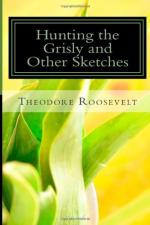Toward the end of our ride we got where the ground was more fertile, and there had recently been a sprinkling of rain. Here we came across wonderful flower prairies. In one spot I kept catching glimpses through the mesquite trees of lilac stretches which I had first thought must be ponds of water. On coming nearer they proved to be acres on acres thickly covered with beautiful lilac-colored flowers. Farther on we came to where broad bands of red flowers covered the ground for many furlongs; then their places were taken by yellow blossoms, elsewhere by white. Generally each band or patch of ground was covered densely by flowers of the same color, making a great vivid streak across the landscape; but in places they were mixed together, red, yellow, and purple, interspersed in patches and curving bands, carpeting the prairie in a strange, bright pattern.
Finally, toward evening we reached the Nueces. Where we struck it first the bed was dry, except in occasional deep, malarial-looking pools, but a short distance below there began to be a running current. Great blue herons were stalking beside these pools, and from one we flushed a white ibis. In the woods were reddish cardinal birds, much less brilliant in plumage than the true cardinals and the scarlet tanagers; and yellow-headed titmice which had already built large domed nests.
In the valley of the Nueces itself, the brush grew thick. There were great groves of pecan trees, and ever-green live-oaks stood in many places, long, wind-shaken tufts of gray moss hanging from their limbs. Many of the trees in the wet spots were of giant size, and the whole landscape was semi-tropical in character. High on a bluff shoulder overlooking the course of the river was perched the ranch house, toward which we were bending our steps; and here we were received with the hearty hospitality characteristic of the ranch country everywhere.




